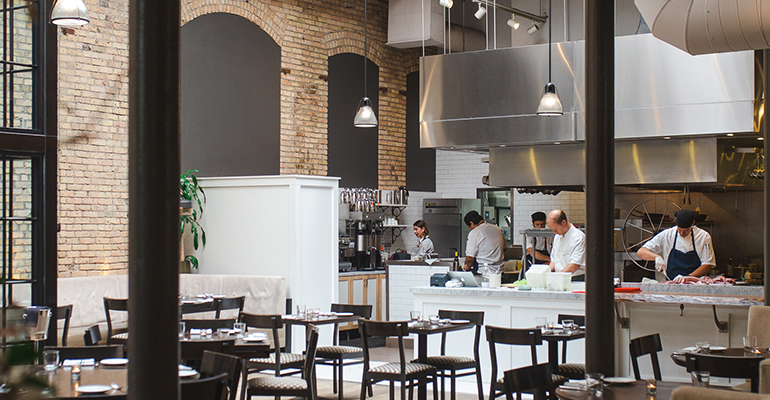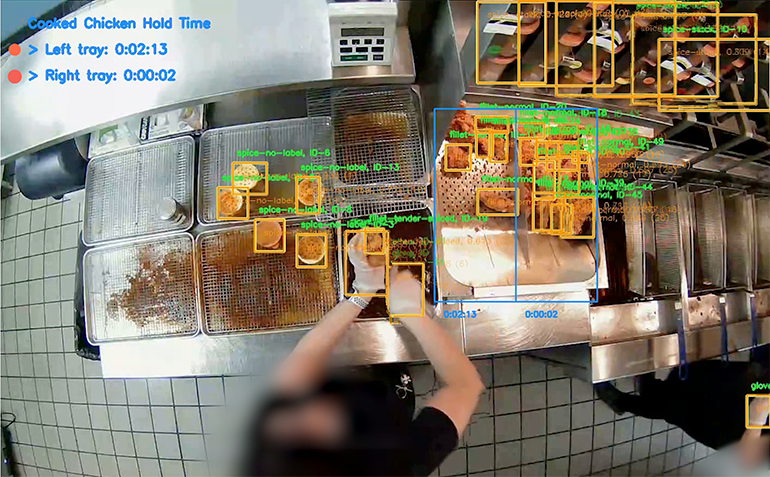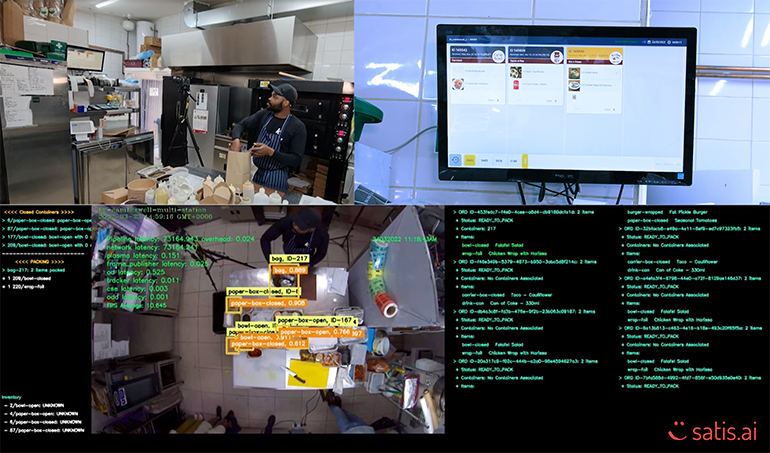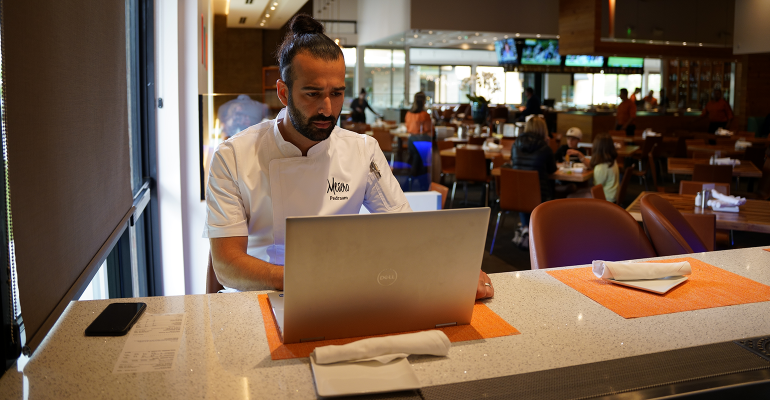As restaurant operators have become more tech savvy, the conversations around technology must-haves have mainly focused on consumer-facing products — from debates around kiosks and QR codes to whether a brand needs a digital rewards program. But operators are starting to wake up to the value of “invisible technology” that customers don’t see, especially since the nuts and bolts of restaurant operations don’t run on loyalty app downloads.
Back-of-house technology — including staffing, workflow, kitchen efficiency, and expense management tools — is getting smarter with a boost from AI and data analytics that can make employees’ tasks easier and kitchen management smoother. While not as visible as a robot server or a series of touchscreen ordering kiosks, technology behind the curtain is just as, if not more, crucial for restaurant operators.
“In the front of house, they're able to place orders through a kiosk or QR code and they can become members of our loyalty program, and there are so many different ways to interact with the restaurant,” said Akash Kapoor, CEO of San Francisco-based Indian fast-casual brand Curry Up Now. “But back of the house has not had the same love. … In a casual-dining setting, the back of house workers can talk to the servers and can say, ‘Slow down some ordering because we’re backed up.’ But in our case, there’s no slowing down, so we keep getting digital orders coming in. The back of the house needs help, and their needs have been ignored for a long time.”
According to NRN’s 2023 Restaurant Technology Outlook survey, while a larger percentage of restaurant owners are looking to invest in customer-facing technology, 38% of operators plan to invest in labor management and back-of-house operations. Additionally, nearly half of operators said they want to invest in training, onboarding, and employee productivity tools. However, back-of-house artificial intelligence remains a huge opportunity for the industry, with only 12% of respondents saying that they use AI for back-of-house tasks like sales forecasting and labor scheduling, and only 8% saying that they use AI for back-of-house operations.
Human-powered >> AI-powered
The survey results are reflective of today’s industry technology trends, as AI has mostly been used in a customer-facing capacity at both the drive-thru lane and to answer phones, while data analytics is usually associated with customer demographics and ordering information. But there are several up-and-coming back-of-house operations tools that use AI and data integration to make employees’ jobs easier — for example, by sorting and analyzing restaurant inventory, scheduling payments, or investigating whether a restaurant is overpaying for some ingredients. In other words, automating what used to be done by hand.
Indeed, transitioning analog tasks to automated capabilities is a common theme with these new back-of-house tools.
“I think [restaurant operations] are going to go from being human-powered, like manually uploading data into a system, to a more connected system that will do all of the work for you,” said Ty Wilson, CEO and cofounder of expense management platform Tab Commerce. “We’ll take care of the heavy lifting. … It’s all behind the scenes, and I think there’s going to be a lot more emphasis on insights gained from that data.”
This type of technology isn’t just a necessity for high-volume QSRs; it could even be helpful in a fine-dining restaurant’s kitchen. Chef Gavin Kaysen, founder of Soigné Hospitality Group in Minneapolis, recently made the switch from using handwritten recipes in binders (or sometimes shared Google docs) to transferring each of his restaurants’ and bakeries’ recipes to a culinary workflow app called Opsi that enables interactive digital recipe books and task lists for chefs. Chef Kaysen is an investor in Opsi and said that it was crucial to streamline operations in his kitchen in order to keep up with the challenging labor market.

Gavin Kaysen recently made the switch from using handwritten recipes in binders.
“The team itself is able to map out their day in a way that makes it work for them,” Kaysen said. “When they’re coming into work, they can go into the app and figure out what recipes they need to make that day. … You’re effectively empowering your team to say, ‘Look, we're all one and we're going to get through our day-to-day operations.”
Kaysen has even considered implementing other kitchen technology to ditch paper receipts for good and switch to monitors all over the kitchen, though he has not made the leap yet.
Ease staffing woes
Besides automation, a major goal of back-of-house tech is to make employees’ jobs easier, and in some cases, replace certain human jobs in challenging staffing environments.
Juan George, cofounder of restaurant technology investment firm 858 Partners, uses Sweetgreen as an example. The Los Angeles-based salad chain’s CEO Jonathan Newman predicted that in five years, Sweetgreen stores would be fully automated. While this path will likely not work for all types of restaurants, George said that back-of-house AI stands to materially reduce the workforce for most restaurants, in order to cut costs and improve metrics for an industry that already has razor-thin margins. One job that could be on the chopping block? Assistant general manager.
“The AGM position is the perfect one to put a target on, because in theory they could be replaced by an AI copilot,” George said. “Their job is scheduling people, creating shifts, and ordering food. … AI could go back and look at ordering patterns and data and give you a better forecast for what’s coming and what food you need to order than a human could. It’s the perfect use case for saving $50,000 a year.”
Not all “invisible” tech tools are designed to replace human jobs — many are just trying to make their lives easier. Updated kitchen display systems are good examples of this. Take, for example, Satis.AI, which uses a combination of AI and cameras to show real-time analysis of employees packing up orders, alerting employees when they make a mistake and telling them when to put the fries in the bag so they don’t get cold waiting for the rest of the order. The technology itself is meant to assist employees in increasing accuracy for delivery and to-go orders, not to replace them entirely.

Satis.AI uses a combination of AI and cameras to show real-time analysis of employees packing up orders.
“If we can rethink how the job is done, we can both build a profitable business and also have happier people in the long run,” said Mo Khodadadi, founder and CEO at Satis.AI. “It's not that easy to find people to do this type of job. … Operators want to know, ‘Where is my time going? What is my staff doing?’ Hence, a lot of these technologies coming into the mix. It’s all about, how can I have my kitchen do more order with fewer costs?”
Pittsburgh-based sandwich chain Primanti Bros. has also been using invisible technology to eliminate paperwork and grunt work for its regional managers. In working with IBM RPA (Robotic Process Automation), the company has refocused its technology investment on back-office tasks like automatically creating monthly forecasting spreadsheets. But that doesn’t mean Primanti Bros. is about to become a sandwich shop staffed by only robots.

Satis.AI is meant to assist employees in increasing accuracy for delivery and to-go orders, not to replace them entirely.
“One misconception there may be is that we will start using bots and stop using humans,” said Caitlin Stritmatter, Primanti Bros.’ director of financial planning and analysis. “That is very much not the case. We’re just trying to take thoughtless and time-consuming work and letting a bot do that. … [The tech] is not going to eliminate any positions; it’s just going to strengthen the team that we have so people aren’t getting burnt out copying and pasting all day.”
Cost, complexity, and integration hurdles
In an industry where every dollar and every minute counts, most restaurant technology experts and operators agree that these tools are still in nascent stages and in many cases are very expensive to invest in. Right now, many of these solutions are out of reach for emerging restaurants and may only be financially feasible for larger chains with hundreds of locations.
“But we believe as the system learns more and more, it will become accessible to even a smaller player,” Khodadadi said. “There is also a chance to enable culinary creators to piggyback on … cloud kitchens that house five to 10 brands. ... It’s the same thing as in computer technology when we went from server rooms to cloud computing.”
Besides upfront cost, another inhibitor is integration. Kapoor said that at Curry Up Now, while the company has already invested in a scheduling system, POS, inventory and recipe management tools, and a training app at its 21 locations, his managers still adjust scheduling manually.
“Our scheduling — which literally goes down to the minute — has to be done manually today,” Kapoor said. “Those reports (sales per labor hour, prep mix) are available to us, but they don’t talk to each other yet. Our POS system may not give us the ability to automate scheduling or give a predictive analysis of what a prep list should look like today.”

A major goal of foodservice tech is to make employees' jobs easier.
The formula for creating the perfect back-of-house tech stack that automates tasks and also integrates with other tools may not be perfected yet, but it’s getting closer.
“The restaurant business is so complex; I might have a great inventory tool and a great recipe tool but nothing that brings it all together,” Tab Commerce’s Wilson said. “What we keep hearing from operators is they want a single place to log in and get the get a pulse on all different items across the business. [Tab is not] an all-in-one solution; we’re actually trying to empower the anti-all-in-one solution where you can choose your own individual software.”
Kapoor echoed this need, saying that he wished there would be a vendor portal that could bring all tech tools together in one place to eliminate the need for 8-10 apps on a manager’s phone or in a kitchen workspace. Until that happens, operators are (mostly) stuck with pricing and choosing from multiple a la carte back-of-house solutions, many of which might be out of their price range. However, Kaysen emphasized the need for patience as most of these tech tools are long-term investments.
“In the restaurant business, we're very used to immediate gratification,” Kaysen said. “When you invest in technology, it'll take you months and maybe even a full calendar year to look back and think, ‘Wow, that productivity actually saved that saved us money.’ … Eventually, you're like, ‘Wait a minute, where is that $1,000 that we used to spend every month on paper and ink for the kitchen?’ But it’s all just an app now.”
Contact Joanna Fantozzi at [email protected]




